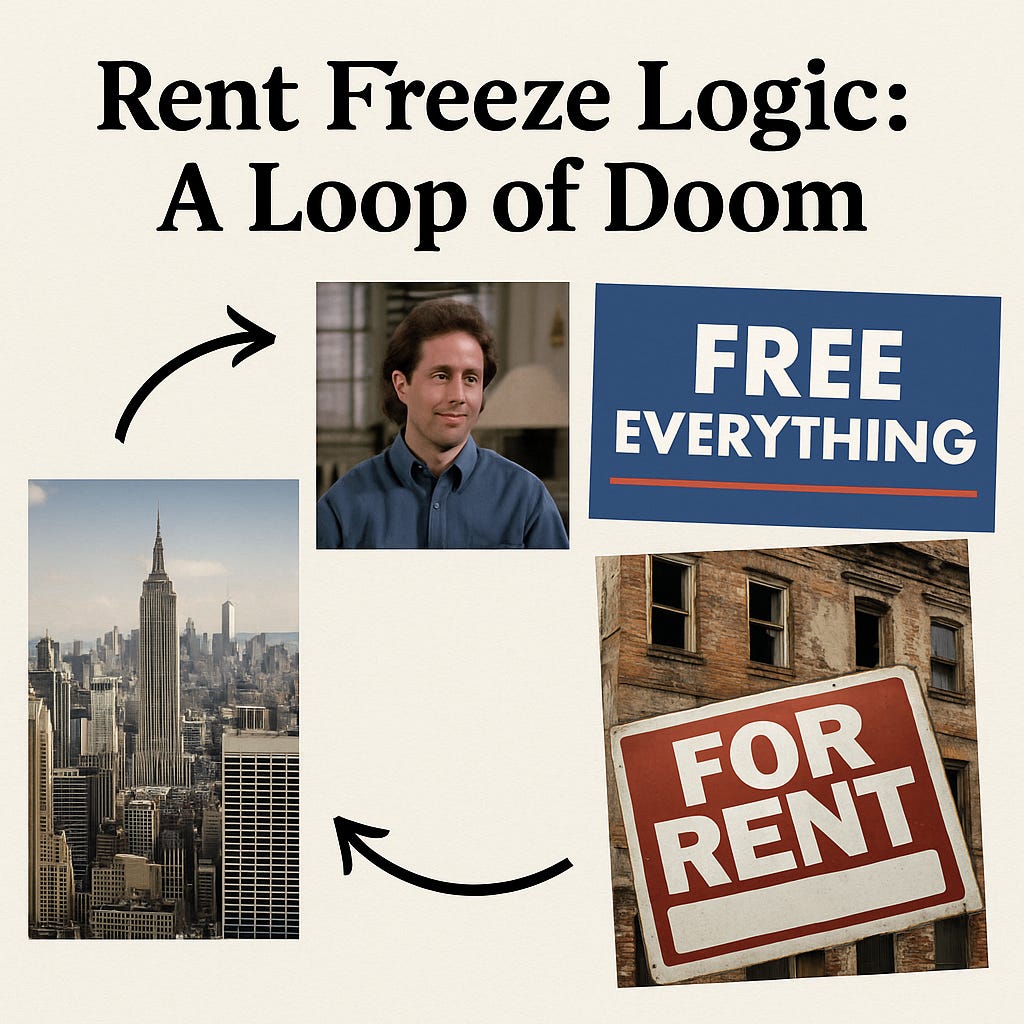Freezing the Market: How Rent Control Rewards Failure
Are we really going to chase this fable one more time?
Freezing the Market: How Rent Control Rewards Failure
By Jim Reynolds | www.reynolds.com
“The goals of rent control and its actual consequences are at opposite poles. What began as a promise of affordability ends as a guarantee of scarcity.”
— Thomas Sowell
California tried it. New York tried it. Europe flirted with it.
Every time a government freezes rents, it swears it’s protecting the poor.
Every time, the same thing happens: the poor end up with fewer homes and worse ones.
The First Law of Frozen Economics
A rent freeze is a price ceiling with a halo.
It tells landlords that even if their costs climb—materials, taxes, insurance, repairs—they can’t charge a dime more. Some hang on out of habit or hope. Most sell, convert, or stop building.
Supply drops. Quality drops. The next generation pays the bill.
Thomas Sowell explained it decades ago: “The goals of rent control and its actual consequences are at opposite poles.”
And yet, the policy keeps coming back. Because in politics, what feels merciful beats what works.
Who Really Pays
At first, the winners seem obvious: tenants in controlled apartments.
But the real payment comes from everyone else—the young family who can’t find a place, the worker who commutes two hours because construction dried up, the small landlord who stops fixing leaks because every repair is a loss.
The government doesn’t cover those costs; it merely hides them.
The loss of new housing becomes the silent tax that no one can repeal.
But beneath every frozen market lies a warmer motive.
The Hidden Motive
No serious lawmaker believes rent control works economically.
They believe it works politically.
A frozen market breeds dependency, and dependency breeds loyalty.
If the tenant’s survival depends on government-mandated mercy, loyalty becomes a survival skill.
That’s why bad ideas never die—they vote.
Sowell said, “There are no solutions, only trade-offs.”
But for a politician, there are no trade-offs, only constituencies.
The system doesn’t collapse; it calcifies.
The same people stay in office promising to fix the same problem they created.
The Trade of Illusions
Rent freezes are political morphine.
They numb pain long enough to win an election cycle while letting the disease spread.
The day the policy begins, construction stops; the day it ends, the shortage begins to heal.
That’s not economics—that’s physics.
History’s record is unbroken:
Sweden’s rent controls after World War II produced waiting lists decades long.
New York’s “temporary” rent controls from the 1940s still distort its market today.
San Francisco’s modern rent caps reduced rental supply by more than 15% and raised rents citywide.
We know how this story ends. We just pretend not to.
And everyone acts surprised, as if this time scarcity might just forget to show up.
The Human Cost
The tragedy is not the landlord’s balance sheet; it’s the renter’s false hope.
Most people struggling with rent aren’t strategists. They’re just trying to keep a roof overhead, feed kids, and stay one paycheck ahead of eviction.
They trust leaders who promise relief.
What they get instead is a policy that dries up the very supply that could have saved them.
You don’t fix scarcity by outlawing price; you fix it by building more of what’s scarce.
That means permitting reform, lower taxes on construction, faster zoning approvals, and fewer bureaucratic choke points. It means saying the quiet part out loud: markets build; mandates destroy.
The Lesson We Keep Forgetting
America is two and a half centuries old.
We’ve learned how to fly, how to split the atom, and how to map the human genome.
But we still haven’t learned that when you freeze a market, you kill it.
We’ve run this experiment from New York to Stockholm to San Francisco, and every time, it ends the same way: with fewer homes, higher rents, and a new round of promises to fix what politics broke.
The people who need housing the most aren’t villains; they’re victims—of an idea that flatters compassion while punishing creation.
We owe them better than another rerun of failure.
If we want to make housing fair, we must make it possible—possible to build, possible to own, possible to dream again.
The rent freeze is not mercy. It’s malpractice.
And the first step toward healing is honesty.
We can’t legislate affordability by freezing reality.




How can I fool thee? Let me count the ways - - -
Superb in logic and simplicity.